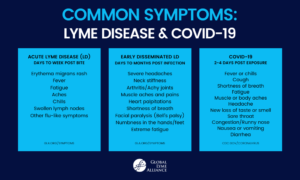Shared symptoms can make it hard to diagnose the aches and pains typically associated with the flu
Heading outside? Especially after months of quarantining, the outdoors provides a much-needed escape, from a simple walk around the block to outdoor sports. Yet why do you suddenly feel as though you are coming down with a “flu”? With the coronavirus pandemic dominating the news, every sneeze, cough or headache makes you wonder if you have COVID-19. But chances are there’s another culprit: Lyme disease. With many overlapping symptoms, how do you know? It’s even harder with children, who may have a difficult time articulating how they feel.
Although most people associate Lyme disease with a distinctive red bulls-eye rash, many never develop one. And fewer recall seeing a tick. So if you come down with non-specific flu-like symptoms within a few weeks of being in outdoor areas where ticks are found, this ranges everywhere from your back yard to neighborhood park, your symptoms could be the first sign of Lyme or another tick-borne illness.
The most common symptoms in acute (aka: early localized) Lyme disease are the ones people are most familiar with. Because they are symptoms often shared with other illnesses, including COVID-19, it’s important to recognize that they could mean Lyme and you should see a Lyme-treating physician right away.
- Erythema migrans (EM) rash
- Fever
- Fatigue
- Aches
- Chills
- Swollen lymph nodes
- Other flu-like symptoms
Symptoms in early disseminated Lyme disease may occur days to months after infection, in which the bacteria have begun to spread. There is a wide range of possible symptoms at this stage, including:
- Severe headaches and neck stiffness
- Arthritis, especially in the knees or other large joints
- Muscle aches and pains
- Heart palpitations or shortness of breath (Lyme carditis)
- Facial paralysis on one or both sides (also known as Bell’s palsy)
- Numbness or tingling in the hands or feet
- Extreme fatigue
When you look at common symptoms of COVID-19 there is a distinct overlap. The following are common COVID-19 symptoms per the Centers for Disease Control and Prevention (CDC):
- Cough
- Shortness of breath or difficulty breathing
- Fatigue
- Muscle or body aches
- Headache
- New loss of taste or smell
- Sore throat
- Congestion or runny nose
- Nausea or vomiting
- Diarrhea
While Lyme is a year-round problem, summer is the peak season for tick trouble. Black-legged (deer) ticks are in their hungry nymph stage. They are about the size of a poppy seed and can be difficult to see on clothing or skin. Because they are so tiny and their bite painless, these ticks are generally not detected. They also tend to attach to the body in areas you can’t readily see, like the armpits, scalp, groin and behind the knee.
This year, with the global emergence of coronavirus, early Lyme disease might be mistaken for COVID-19, since the illnesses share a number of symptoms—a low-grade fever, head and body aches, chills and fatigue. This can make it more difficult to diagnose someone for Lyme who has not noticed a rash or was unaware they ever had a tick bite. Two key differences in symptoms with COVID-19 are respiratory impact (coughing and difficulty breathing) as well as loss of taste and smell— symptoms not typically associated with Lyme.
If your flu-like symptoms last a few days without signs of improvement, contact your doctor and request that you be tested for Lyme and other tick-borne diseases. Since early detection is key, it may be helpful to see a Lyme literate medical doctor versed in their complex symptomatology of tick-borne diseases. Although current diagnostic tests are unreliable, it’s still a good idea to get tested, and ask about taking a prophylactic course of antibiotics.
When Lyme is diagnosed and treated in its early stages, most individuals recover completely. But delays in treatment can lead to more severe, debilitating health problems, months or even years later, including potentially fatal heart conditions, painful arthritis, neurological and cognitive issues including trouble with memory or concentration.
Of course, the best way to prevent Lyme is to Be Tick AWARE™ and protect yourself from any and all tick bites. For more on Lyme disease, prevention, detection, diagnosis, treatment, and patient support services visit GLA’s BeTickAware.org page to access videos, fact sheets, and a host of educational materials to help keep you and your family safe from tick-borne diseases.
While COVID-19 is a serious health threat, Lyme and other tick-borne diseases are other menaces to be on the lookout for.
Additional COVID-19 and Lyme Disease Resources:
GLA POV: Parallel Pandemics: COVID-19 and Lyme Disease
Blog: Q&A on COVID-19 and Lyme Disease with LLMD
Blog: Personal Patient Experience with COVID-19 and Lyme Disease
Video: Webinar with Dr. Cameron and Lyme-COVID-19 patient
Letter: GLA CEO Addresses COVID-19 and GLA Community
Letter: GLA Chairman on What We Can Learn from COVID-19 Response

GLA
Admin at GLA







-2.jpg)